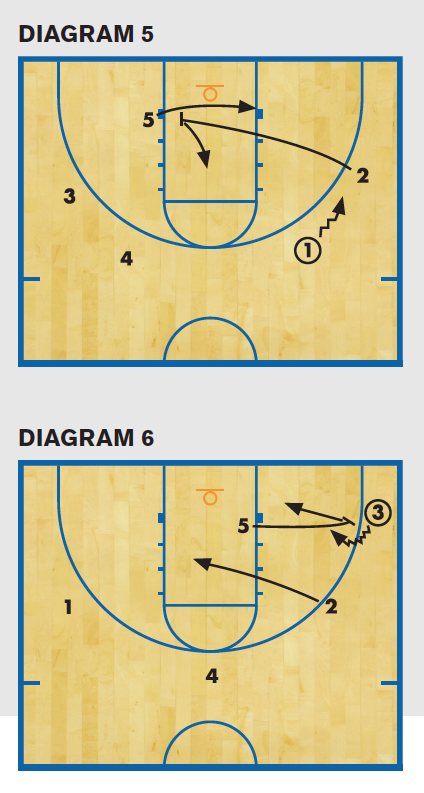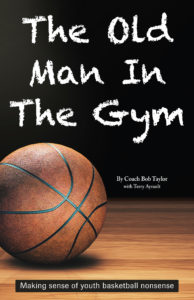A four-out, one-in offense that overwhelms defenses
Our teams have won eight conference championships, completed four undefeated seasons, put together a 52-game winning streak and compiled a 205-14 record over the past 11 seasons. All of that success began when I switched to this four-out, one-in offense.
The offense is simple, and that’s why it works so well at the middle and high school levels. It’s basically a read offense — no plays are called. These kids are not going to play for us forever, so we want to teach them to read the defense and react to what it gives them.
The diagrams show you all the different options our players have. If they switch, one option opens up, and if they don’t, there is another option waiting.Learning the offense
 DIAGRAM 1: This is the basic look for the set. Most coaches set their 5 on the ball side, but I prefer to set him on the opposite block to open up things for my point guard. I always tell my point guard he is the first option. If he can take his guy off the dribble, he should go for it. If no one helps, he gets to the rim for a layup. If the defense helps, that leaves someone open.
DIAGRAM 1: This is the basic look for the set. Most coaches set their 5 on the ball side, but I prefer to set him on the opposite block to open up things for my point guard. I always tell my point guard he is the first option. If he can take his guy off the dribble, he should go for it. If no one helps, he gets to the rim for a layup. If the defense helps, that leaves someone open.
 DIAGRAM 2: This is the basic continuity of the offense. After 1 passes the ball to 2, they cut through to the opposite side always looking for the ball. 5 sets a screen for 3, who cuts down the lane.
DIAGRAM 2: This is the basic continuity of the offense. After 1 passes the ball to 2, they cut through to the opposite side always looking for the ball. 5 sets a screen for 3, who cuts down the lane.
If the defense doesn’t switch, the curl cut is open almost all the time. If it switches, you now have a mismatch in the post with your 5 sealing off and looking for the easy basket.
 DIAGRAM 3: If nothing is available, the ball is kicked out to 4, who dribbles to the opposite side to restart the offense. As 4 is dribbling, there are a couple of options they can look at — 5 on the block sealing off, and 4 with dribble penetration.
DIAGRAM 3: If nothing is available, the ball is kicked out to 4, who dribbles to the opposite side to restart the offense. As 4 is dribbling, there are a couple of options they can look at — 5 on the block sealing off, and 4 with dribble penetration.
After 4 dribbles to the opposite side, everyone is back in the original alignment and the continuity starts over on the other side.
DIAGRAM 4: This offers additional options out of the set. If 1 is having problems getting things started, 5 always has the option to set a high ball screen for 1. 1 comes off the screen and looks to attack the basket, or they have 5 in a pick-and-roll situation. 2 fades to the corner, looking for his shot if his defender helps off. 3 and 4 switch places just to occupy the help-side defense.
 DIAGRAM 5: This shows another option with 1 dribbling at 2. This is 2’s sign to either screen for 1 or screen away for 5. 5 comes off the screen looking for the ball, and 2 pops high looking for a shot.
DIAGRAM 5: This shows another option with 1 dribbling at 2. This is 2’s sign to either screen for 1 or screen away for 5. 5 comes off the screen looking for the ball, and 2 pops high looking for a shot.
DIAGRAM 6: This is an option that I just put in last season. If the curl option is not there, 3 cuts all the way through to the corner. Anytime 2 passes to 3 in the corner and cuts through to clear out, 5 comes and sets the screen for 3 for a little two-man game. Once again, if you get the switch, 5 should get a mismatch on the roll and, if not, 3 should get a good shot opportunity.
When practicing and teaching this offense, I usually break it down into sections and use three- or four-man teams. As an example, when teaching the curl cut with the 5 screen, I’ll have 1 up top with no defense and 2, 3, and 5 all with defenders. 2 has to get open on the wing and have that pressure on the pass. 3 and 5 have defenders so they can all make the right read.
There are a lot of options out of this offense and just running the continuity can produce points, especially at the middle and high school levels. This offense provides so many options from this set, that you can typically find a mismatch anywhere on the floor.
Nick Lusk has coached basketball for 21 years. He’s is the former boys basketball coach at St. Francis Central Catholic in West Virginia.









